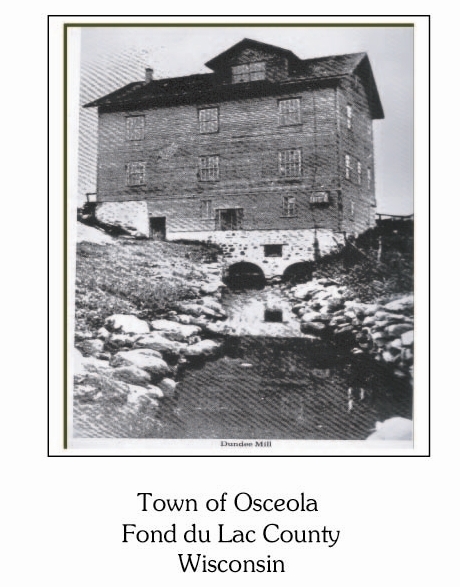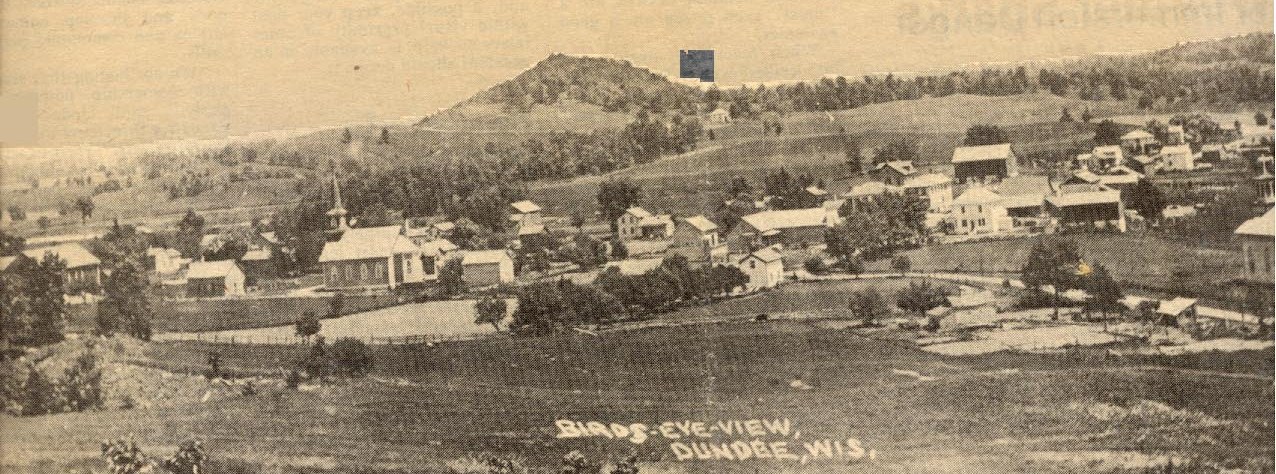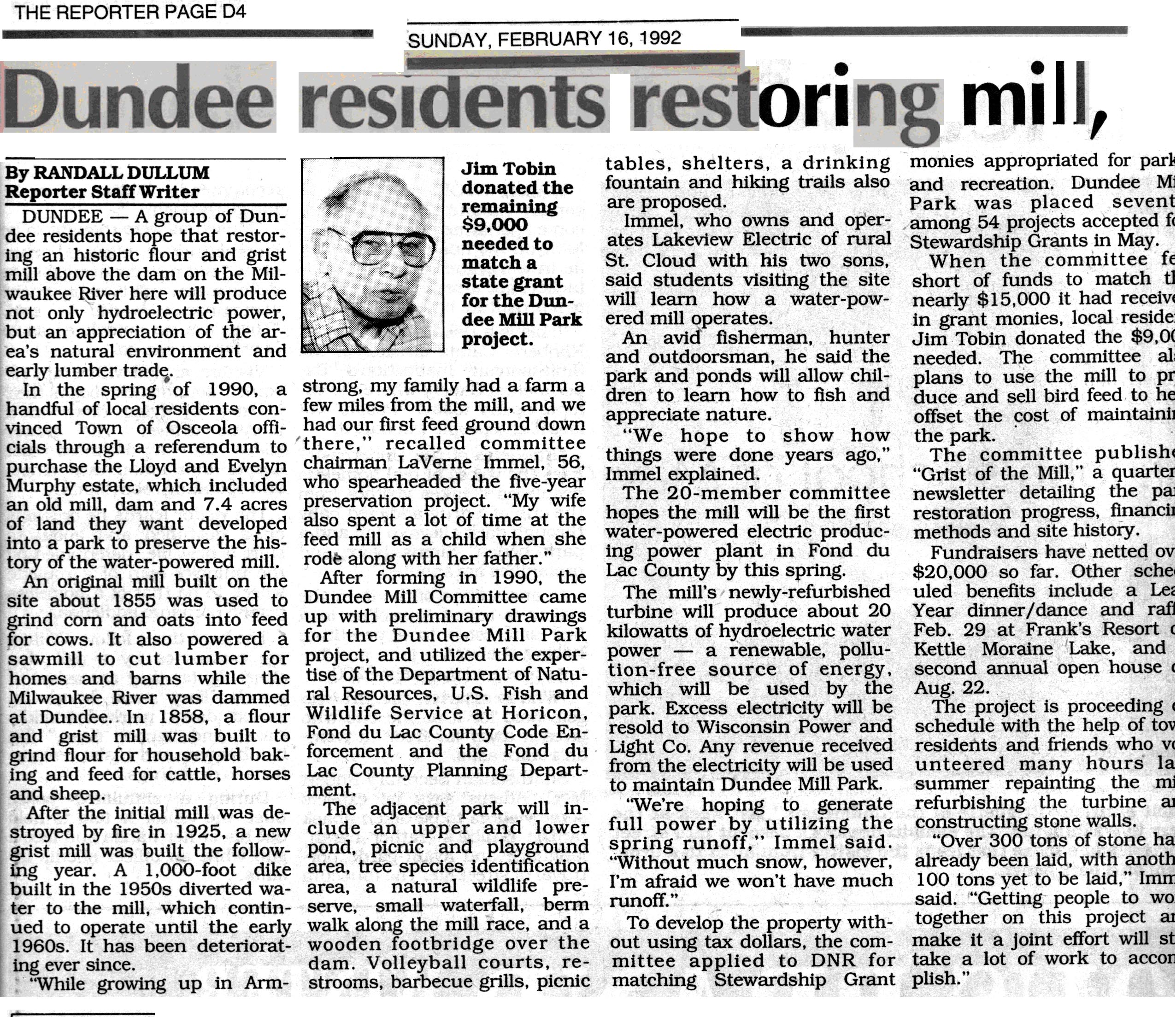
|
Mill History

For Dundee
Time Table
Click Here
In 1847, Wisconsin was part of the Northwest
Territory. The federal government issued a grant for the development of water
power in what was to became the Village of Dundee in the southeast corner of
FondduLac Co. Men from Europe and eastern United States roamed the area in
search of locations on rivers and lakes suitable for a water-powered mill. As
the area to the north of Dundee was fed by springs, a few of these men decided
to build a mill in Dundee.
|
In 1855, E.M. McIntosh and Stephen Palmer built the dam, formed the berms,
created the millrace and built a sawmill. The dam was built to raise the water
level sufficiently to drive the water wheel, creating what we now know as Long
Lake. A large causeway was cut through a limestone ledge to form a channel. The
mill became a reality. Trees were plentiful but lumber for building was scarce.
The sawmill operators looked forward to a successful business. But the
population of the area did not increase as expected and the demand for lumber
declined. The sawmill fell on hard times and discontinued operations. |
|
Pioneer farmers were growing wheat successfully in the virgin soil of the area.
The wheat needed to be milled to meet the increasing demand for flour. With a
few refinements, the sawmill became a flourmill. Wheat was shipped into nearby
Campbellsport by train and carried into Dundee by horse and wagon. After the
wheat was milled, the procedure was reversed and the flour was shipped to
national markets.
|
|
The early 1870s brought challenges. The soil became exhausted. Grain rust and
smut plagued crops for several seasons. The cinch bug, a grayish black insect
with a mosquito-like beak, made its appearance, drilling holes into the stalk of
wheat and sucking the juice. By the 1880’s, wheat growing and milling were
halted.
|
|
In the 1880s Jacob Arimond took over the mill from Frank Hollister. The
grandfather of the local Arimond family had settled in Dundee, purchasing the
store and stock from A. Larsdt in May 1866. Three years later, he built a large
two-story building in Dundee and moved his store to that location. The store
also housed the local post office. Jacob and his son Leo Arimond started the
Dundee Electric Company between 1898 and 1900. A large dynamo was installed in
the mill and electric lines were strung to both Cascade and Campbellsport. In
combination with the driving power of the water-driven turbine, the generator
could not produce enough electric power to send direct current eight miles to
Campbellsport and the business failed.
|
|
After the failure of the Dundee Electric Co. and the death of Jacob Arimond, the
family sold their property in Dundee including the mill. Dairy farming in the
area was on the rise. Some farmers did not immediately build silos. They raised
oats and winter wheat, which needed to be ground into grist to feed their cows
over the long Wisconsin winters. The mill again turned to grinding grain.
|
|
The 3-story mill building was destroyed by fire in 1925 and rebuilt in 1926 as a
2- story building. 20th century mill operators included John Schenk, Herman
Molkenthein, Bill Little, Henry Kelling, Albert Koepke and Lloyd Murphy. |
|
This episode took place in approximately 1936 or 1937. Many
years ago, my dad and I made a trip down to the mill to have oats ground into
feed for the cows. I, of course, had to go along because wherever my dad went, I
was not far behind. I had to be three or four years old. I was with Dad at the
mill where we went every week. As my mother told it, I must have been looking
down in the hopper where Dad had emptied bag of grain. He went out to the wagon
for another bag of oats, and when he came to dump it in the hopper, I was down
in the hopper, crying like the devil, which was a good thing or I would have
been covered with oats from the next bag! No one would have known where I was
because when the mill was running, it got pretty noisy in there.Between my dad
and the miller--whose name I think was Kehling--they got me out and no harm was
done to me. But I was awfully scared, and my dad was, too.
|
 |
|
1980 Aerial View of Dundee with hwy 67 coming in from the right. |
|
Milling was discontinued in the 1950’s and the building fell into a state of
disrepair. In 1990 the Town of Osceola purchased the mill property. The Partners
of the Dundee Mill & Park was formed and the property started being restored.
|
|
|
 |
|
|
|
Mill Improvements in 2023 |
|
CLICK HERE
|
|